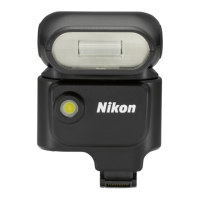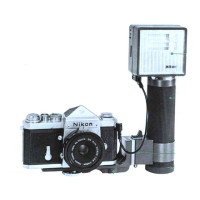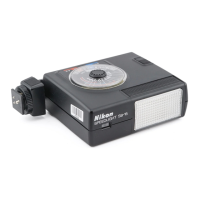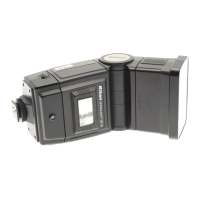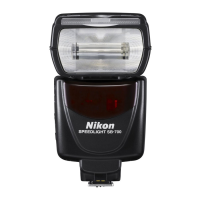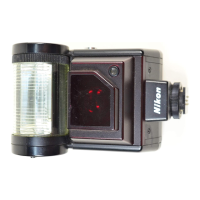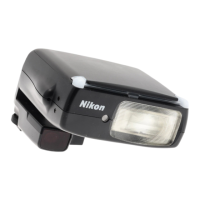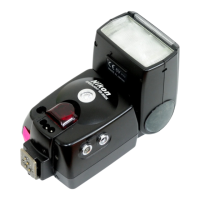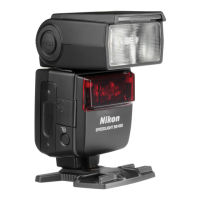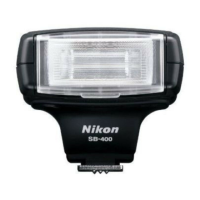CONTROLS
IN
DETAIL-continued
___
_
Exposure Compensati
on
When using TTL automatic flash control with the
Nikonos-V camera, you can use its ASAIISO film speed
dial to make
an
exposure compensation for the shooting
situation or to create intentionally
over- or underexposed
photos.
The
relationship between the exposure compensation
value and ASA/ISO film speed dial setting
is
shown
in
the following chart:
The
useable aperture range
and
flash-to
-s
ubject cou-
pling distance range for TTL automatic flash photogra-
phy changes according to the exposure compensation
value being used. When making
an
exposure com-
pensation, use the aperture/shooting distance combina-
tions
in
the reset ASAIISO film speed column
in
the
exposure calculation chart. For example, when making
Ready-Light
@
After its power switch
is
turned
on,
the ready-light
on
the S8-103 will light to indicate that the speedlight has
recycled and
is
ready to fire. If you are using either
a Nikonos-V or Nikonos
IV-A
camera, its viewfinder
ready-light will also light at the same time to let
you
know the speedlight
is
ready for the next shot.
In
addition, the viewfinder ready-lights of the Nikonos-V
and Nikonos
IV-A
blink to warn of improper settings. If
this happens, check that: the camera
and
flash unit are
securely connected,
and
the shutter speed/shooting
mode and ASAIISO
fi
lm speed
on
the camera are cor-
rectly set.
20
a
+2
exposure compensati
on
while using ASAIISO
100
film, use the aperture/shooting distance combinations
in
the ASAIISO
25
column
in
the exposure calculation
chart.
o
Po
sitive
(+)
exposure compensation cannot be made when using ASAI
I
SO
25 film, and negative
(-)
exposure compensation cannot be made
when using ASA/ISO 400 film.
In
these cases, make
the
necessary
compensation
by
using one
of
the manual flash modes. Note that the
Nikonos-V's viewfinder ready·light blinks
if
you attempt to make a
-2
or greater exposure compensation while using
ASA
/
ISO
200 film, or
a
-lor
greater exposure compensation while using ASAIISO 400 film
in
the
TTL
mode.
o When you finish making the exposure compensation,
be
sure to reset
the
ASA
/ISO film speed dial
on
the Nikonos·V to its original setting.
. o
lf
you photograph a subject with very high
reflectivity-such
as a
mirror or metallic
surface-in
the
TTL
mode, underexposure is almost
certain to
occur
.
To
prevent this, use manual control.
o
The
ready·light goes out when the flash
unit
is turned off.
o
When
the exposure meter
of
the Nikonos
-V
or
Nikonos
JV.A
is not
activated, the camera's viewfinder ready-light will not light even
if
the
speedlight
is turned
on
(except when the shutter speed/mode selector
dial
or
shutter speed dial is set
at
MOO
or
M). Always confirm that the
viewfinder ready-light is lighted before shooting.
o
When
the shutter speed/mode selector dial
or
shutter speed dial
of
the
Nikonos·
Vor
Nikonos
JV.A
is set
at
MOO
or
M, the viewfinder ready-
light lights when the flash unit ready-light lights.
o
As
the voltage
of
the batteries decreases with use, the GN
of
the flash
unit decreases slightly.
o
The
voltage
of
NiCd batteries decreases rapidly when their power is
almost exhausted, increasing the recycling time.
When
this occurs,
stop using them immediately and recharge them or they may be
damaged.
o
When
using alkaline-manganese batteries,
if
recycling takes 30
seconds
or
longer, replace the batteries with a fresh set.
oA special red
LED
is built into one end
of
the
firing tube to ensure stable
light output.
If
you
release the camera 's shutter before
the
S8-
103
is
fully
recycled,
the
LED might light
up-this
is not a malfunction.
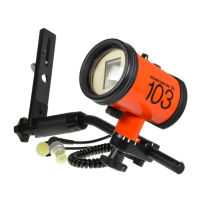
